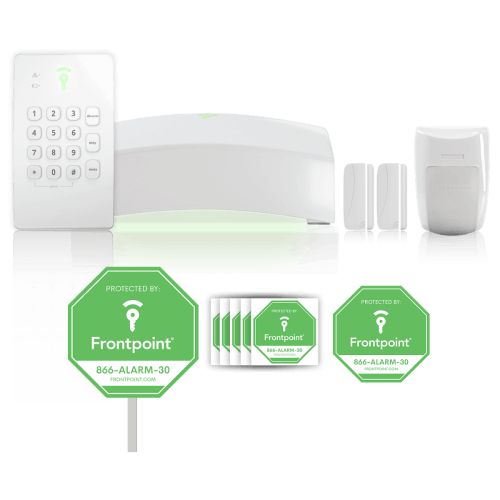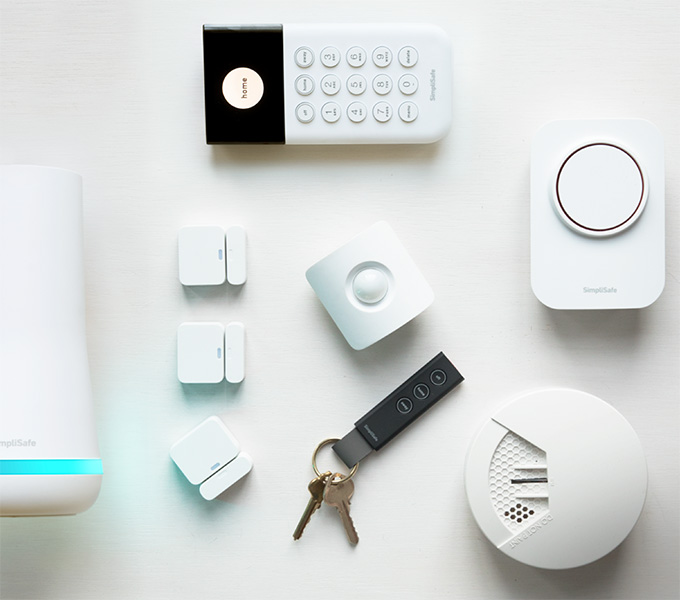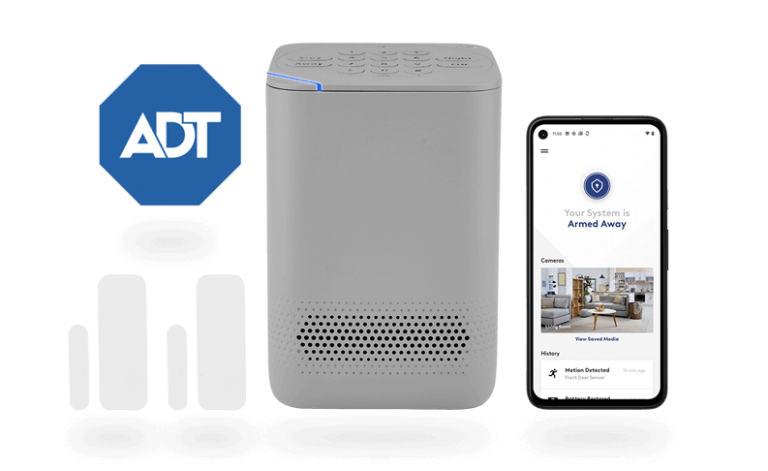What is a wireless security system and which one is best for you?
Best Wireless Security Systems
Home security systems are a huge asset to your safety and theft protection - but dealing with the setup and wiring can cause a serious headache. The best wireless security systems offer flexibility and convenience, but "wireless” can actually mean a few different things for a home security system, and it can be confusing.
We’ll break down the different ways the word is used to help you understand what a company really means when it promotes its system as wireless. But first, here’s a sneak peek at our top recommended wireless security systems.
- : Best professionally installed
- : Best customer service
- : Best for basics
- : Best value
- : Excellent alternative to ADT

Data effective 05/08/2023. Offers subject to change.
Save some money on your new home security system with these deals
Data effective 5/08/2023. Offers subject to change.
Snag 65% off equipment and a free HD indoor camera with Cove. Get the deal now while supplies last.
Frontpoint is currently offering 40% off their entire site plus a free wireless doorbell camera with code WIRELESSDB. Check out the sale.
What to look for in a wireless security system
When people say “wireless home security,” they often mean two different things: wireless, which refers to how sensors connect to a control panel, and cellular, meaning how your system communicates with an external monitoring center.
Wireless security systems use radio frequency (RF), Wi-Fi connections, and other technologies to link security sensors to the system hub. Z-Wave and Zigbee are some of the more common alternate wireless technologies used by major security companies. They’re sometimes used for system components, but they’re frequently also used to connect systems to compatible third-party smart home products.
Cellular-based systems communicate with your security company’s monitoring center or centers using cell signals instead of communicating through a hardwired connection.
Wires are a thing of the past, and the truth is, most security companies have made the switch to wireless technology in one way or another. Systems that don’t have to be hardwired are just more convenient. You’ll just want to clarify if wireless refers to the sensors only or if it means the communication between your system and the monitoring center—or maybe it’s both.
The systems in this review use both wireless connectivity and cellular connections to do their work. In fact, you’ll be hard-pressed to find many home security options that use landline (the monitoring center communication method used before cellular).
Security system features of wireless systems:
- Tamperproof ”Crash & Smash” technology
- Not as intrusive as some wired systems
- Easy installation
- Portable
Tamper-proof and Crash & Smash technology
Crash & Smash and other tamper-proof technology combined with cellular monitoring make it so no one can disable your system by cutting your phone line or ripping your control panel off the wall. If your system detects someone tampering with the control panel, it will immediately alert the central monitoring center.
Less intrusive and easier installation
Stick-on wireless sensors that connect to your system control panel make installation less intrusive. There’s no need to drill holes in the wall to run wires, and you have more flexibility to choose where you place your sensors. These sensors also make it easy for do-it-yourself installation, which means you’ll save on installation fees and you won’t have to schedule a technician to come to your house. That’s perfect if your schedule is more rigid.
Easier to take with you if you move
Because there’s no need to drill and run wires during installation, wireless systems are easier to take with you when you move.
Most home security companies allow you to transfer your system to your new place with little hassle, especially if it has DIY installation options. This is great for renters who might switch apartments periodically.
Vivint: Best professionally installed
Overall, Vivint is our pick for best wireless home security system. It uses a combination of Wi-Fi and cellular technology to deliver its signals, and it has flexible pricing options, high-end equipment, and a superior home automation experience.
However, it’s really expensive. Like, “potentially more than all your streaming subscriptions put together” expensive. And you might run into some customer service snags. For those reasons, Vivint is for people who want the best of the best and aren’t on a budget or don’t want to DIY.
Vivint uses both wireless sensors and cellular communication in all of its security packages. It’s one of the leading companies in home automation technology and innovation, and it designs most of its own equipment, including the Vivint video doorbell.
For even the most basic package, though, you’ll pay around $600.

Source: Vivint
We recommend Vivint’s Smart Home monitoring plan because you’ll get the touchscreen control panel and high-end home automation control through the Vivint app.
Plus, the Smart Home plan is cheaper than the video plan. You’ll miss out on cameras, but other than that, you’ll get everything with Smart Home that you get from Vivint’s top-tier package—while saving $4 a month.
Sadly, Vivint doesn’t offer DIY installation. (We know; “inconceivable!”) You’ll have to schedule an appointment for a technician to come out and help you set up your system. Many installers will use the in-home opportunity to upsell—excuse us, “recommend”—additional security products.
It’s not always a bad thing—most of the recommendations have merit, but Vivint salespeople are known for being aggressive and even unethical in their pursuit of a higher sale. Which is even more aggravating when you remember that Vivint is already a lot more expensive than its contemporaries. You can get a perfectly good system for about 25% of the cost of what you’ll pay for Vivint.
Though Vivint’s sensors are wireless, the control panel needs to be installed by a professional and connected to a power source. It uses cellular technology to communicate with the monitoring center, so it checks both “wireless” boxes. But keep in mind that a technician will drill small holes to install the control panel on your wall.
Data effective 5/08/2023. Offers subject to change.
Frontpoint: Best customer service
No matter which Frontpoint package you choose, you’ll get 100% cellular monitoring and wireless technology. We also like that Frontpoint is up-front and transparent about all of its pricing. Plus, it doesn’t require a contract.
Like Vivint, it’s super pricey. But unlike Vivint, it’s DIY. So if you’re in Vivint price ranges but are all about doing things yourself, Frontpoint might be your sweet spot.
In addition to Google, Alexa, and Z-Wave compatibility, Frontpoint gives you home automation control. That includes access to your lights, locks, and thermostat, all from your smartphone.
Just remember—you only get an option for one type of monitoring plan for a grand total of $49.99 a month, unless you specifically call to order Frontpoint's 2-year or month-to-month plans. And that’s without the equipment costs, which start at around $129 for the basic package.

Source: Frontpoint
Again, Frontpoint takes a DIY approach to installation, and, for the most part, it’s pretty easy to install. However, it can be frustrating if you run into troubleshooting issues during installation—we’re looking at you, doorbell camera—but Frontpoint reps will walk you through the process step by step if you need help.
In fact, we’d say that Frontpoint has some of the best customer service in the business. If it would just lower its prices a tad, everything about it would be customer-friendly.
Data effective 05/08/2023. Offers subject to change.
Cove: Best for basics
Cove is a fierce competitor for the title of best wireless security system. Unlike most of the security systems on our list, it doesn’t use Wi-Fi at all. Cellular is its primary connection, not just its backup.
It’s also cheaper and has 24/7 video recording capabilities, something you don’t usually see in a DIY system. But you gotta pay extra to use the app.
Cove doesn’t really do packages; you’ll have to choose the equipment you need yourself. That’s great because you can pick only things you want, but it can also be a little daunting if you’re not familiar with security systems.
In addition to the typical security products (control panels, door and window sensors, motion detectors), Cove also sells some extras like CO detectors and medical alert devices. Cove also offers two video doorbells, and a few other security cameras options that aren’t quite up to snuff with the features we see in other security camera systems.
Unfortunately, you can’t use most of the extra stuff without paying $10 more a month. That’s not precisely highway robbery, but it’s less than cool to put all the best features behind a paywall.
Still, Cove is overall much, much less than Vivint or Frontpoint.
Cove monitoring services include communication innovations that the brand calls TripleTouch, InstaText, and LiveAssist. Basically, they’ll help you get any professional help you might need in an emergency. For more info, check out our Cove review.
Oh, and if you want the cameras, you’ll have to pay for a separate support plan. But hey, at least Cove doesn’t require a contract. You can quit at any time.
Also, you’re responsible for installing this whole kit and caboodle yourself. As you’ve probably gleaned, most DIY wireless alarm systems aren’t terribly complicated to put together. But if you consider yourself something of a Luddite, you might need a little assistance.

Source: Cove
Data effective 05/08/2023. Offers subject to change.
SimpliSafe: Best value
SimpliSafe is the pumpkin spice latte of home security—it’s basic. But in this case, that’s a good thing. SimpliSafe keeps the bells and whistles to a minimum, focusing more on functionality and affordability.
It also uses Wi-Fi for its primary wireless connection but has a cellular backup in case your network ever goes down.
SimpliSafe combines a no-contract policy with some of the lowest monitoring prices available. You have the option to pay as you go for cellular monitoring or shut it off completely and monitor the system yourself.
You do have to purchase all of your equipment up front, but in the long run, it’s easily the most affordable wireless security solution on our list. You’ll get a lot more bang for your buck with SimpliSafe than most other security brands.

Source: SimpliSafe
Between the two monitoring plans, we like the SimpliSafe Interactive option. At $27.99 per month, SimpliSafe’s top-tier package is still super affordable compared to the other companies on this list. It’s practically a steal.
SimpliSafe also offers customers of the Interactive monitoring plan 10% off equipment add-ons and a lifetime warranty as long as they maintain their subscription which is a pretty good deal. The Interactive package adds more control to the SimpliSafe system with mobile access and both text and email notifications.
While SimpliSafe offers a handful of useful smart devices, like its own smart lock and cameras, it doesn’t connect to most third-party smart home products. So if you want a full-on smart home suite, don’t go with SimpliSafe, which is an island unto itself.
But do go with SimpliSafe if you want to play it simple (and safe). You can get your security system set up and armed in a manner of minutes.
Data effective 05/08/2023. Offers subject to change.
ADT Self Setup: Excellent alternative to ADT
Ah, ADT Self Setup. If you want free self-monitoring with no contracts and pretty cameras, you can’t go wrong with ADT Self Setup. But know that if you choose the free option, your wireless system won’t have a cellular backup. You’ll be Wi-Fi-dependent unless you choose to pay for the professional monitoring service.
Still, even if you decide to go pro, ADT Self Setup's $20-a-month professional monitoring plan isn’t that bad next to Vivint or Frontpoint’s prices. And we really like that you can switch between professional and self-monitoring at will. That’s helpful for anyone with a flexible schedule.
We suggest starting with the Starter Plus system. The four door and window sensors and two motion sensors that come in the package should be more than enough to provide a basic safety net for your home.
Also, ADT Self Setup has all the cameras you can want or need, and they all come with facial recognition. Like most facial recognition software, ADT Self Setup is a bit rough and doesn't recognize everyone. But apart from that (and the outdoor camera’s penchant for not staying connected to the Wi-Fi), we like the cameras. We think the best wireless security cameras have these extra features. They look a lot nicer than most security equipment too.

Source: ADT
Also, ADT Self Setup definitely has the best home automation of any service on our list. It works with not only Alexa and Google but also Z-Wave Plus and IFTTT, a cause-and-effect platform that allows users to create advanced smart home chains.
Data effective 05/08/2023. Offers subject to change.
Recap: Best wireless security systems
- Vivint is the fanciest wireless system out there. It has lots of home automation but high prices.
- Frontpoint uses a combination of wireless and cellular technology and offers excellent customer service.
- Cove uses cellular connectivity only. It’s cheaper than most of the other offerings but requires more money to use the app.
- SimpliSafe uses wireless technology with a cellular backup system. It’s an extremely functional and affordable system but lacks smart home connectivity.
- ADT Self Setup has free self-monitoring but offers cellular backup only with its paid plan. It has the best home automation out of our wireless recommendations.
Choosing the security system that’s right for you might come down to more than just wireless features. You should check out our best home security systems review, where we break down the top security providers point-by-point.
Methodology
We compare and rank home security systems based on five key factors:
- Price
- Equipment
- Smart home integrations
- Security cameras
- Customer experience
For a best list like this one, which focuses on an aspect of the systems that doesn’t typically weigh heavily in our ranking system, the recommendation order may come out differently than it would in a more standard ranking. You’ll notice that Vivint, for instance, is our top recommendation in this piece but has a lower star ranking overall than Cove.
Best wireless security systems FAQ
Wireless
Old-school security systems have wired sensors that connect directly to a control panel. But these days, most home security systems use radio frequencies (RF) to connect remote sensors (like door/window sensors or motion sensors) to the main hub.
Some home automation equipment, like cameras or smart thermostats, uses your in-home Wi-Fi network to communicate with your smartphone security app.
Cellular
Many modern alarm systems use a cellular connection to communicate with a professional monitoring center. This form of wireless communication works the same way as your cellphone and relies on a cellular signal.
If you live in a rural area where the cell signal is spotty, this feature may not be available, but you should double-check with the company just to make sure.
We like to see motion detection, night vision, two-way audio, 1080p vision or better, and some form of object detection in our cameras. Bonus points if they have customizable motion zones, lights, sirens, facial recognition, or multiple storage options.
Also, most modern users like a wireless security camera to go along with their wireless security system, although there are some hardwired and PoE cameras that we really like.
It’s rare to find a camera with all those features, so not every camera we recommend has them. You can learn more in our Best Home Security Cameras Review.
When you have a wireless camera system, your footage is either transmitted to you over the cloud or saved to a physical SD card. Cloud storage tends to be more expensive than reusable SD cards, but it’s definitely more of a hassle to remove the SD card from the surveillance camera and download the footage.
Unfortunately, yes. Wireless security systems use Wi-Fi or Bluetooth to connect, which means they are vulnerable to hacking. Even though there is a possibility for hacking, there are plenty of things you can do to protect your home and security system like encrypting your Wi-Fi and enabling two-factor authentication.
Wireless security cameras are typically battery-powered. This type of power source can come in handy in the event of power outages, just don't forget to replace the batteries when they're low.
ADT offers both wireless and wired home security technology. You can find build-it-your-own packages alongside complete packages with ADT, so you can customize your system to be as wired or wireless as you need.
A wireless camera battery can last anywhere from two to six months before needing to be recharged. Frontpoint's wireless cameras can last up to six months while ADT Self Setup's cameras will only last up to three months.
Related Articles






